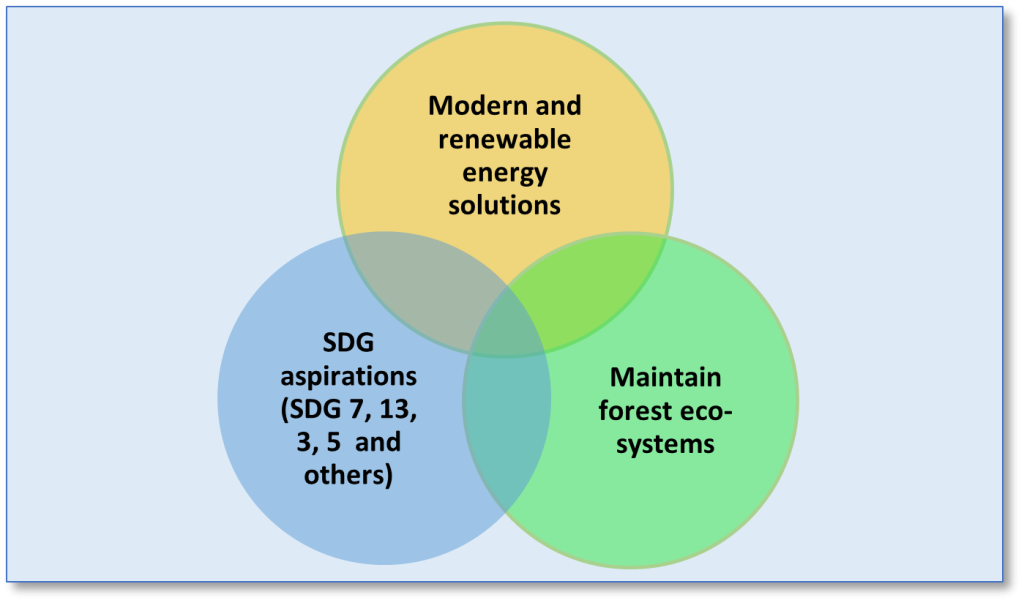- Date
- 14th February 2024
- Categories
- Clean Cooking, COP28, eCooking
1st of the 3 blog series
By Dr Samir Thapa, MECS Programme, Loughborough University
This is the first blog as part of a series of three blogs that looked at COP28 reflections from a cooking transition perspective. This blog synthesises relevant COP28 decisions and discussions with respect to just cooking transitions. This blog and the other two in the series are based on a purposive review and participation of/at 44 relevant sessions, not including the negotiations.
COP28 for the first time allowed ample space for dialogues and discussions on the importance of cooking transitions. Various events, importantly the launch of the Global electric Cooking Coalition and SEforALL SDG7 Global South Pavilion events indicated the importance of cooking transitions to achieving the “1.5 North Star”, cooking transitions that reduce use of traditional biomass and fossil fuels while maintaining the forest eco-system, with crucial SDG benefits. However, these events, outcomes and discussions must also be looked at in relation to the Articles 28 and 291 of the first Global Stocktake final decision, LPG-related statements by participants during COP28 (1, 2, 32), and the cooking transition plan3 of the special report released leading up to COP28. These developments clearly recognize the use of cleaner fossil fuels, particularly LPG and LNG to meet the universal clean cooking targets by 2030 and beyond.

Given that nearly 10% population is expected to continue using LPG in 2050 and taking account of the lack of clarity on the sources of electricity for cooking by 2050, the nature of the “transitional” use of fossil fuels including the possibility of use of “abated” coal for e/Cooking should be clearly analysed. This is important compared to the cooking transitions with the revised goals of tripling renewable energy and doubling energy efficiency rate by 2030 and beyond. The analysis has to consider:
- 1) the continuation of fossil fuel subsidies
- 2) the development of removal technologies, particularly the carbon capture, use and storage
- 3) the incumbency of resources and institutions
- 4) the underlying geopolitics of fossil fuel.
This is also important because previous commitments by developed countries to reduce emissions by 25-40 percent are unmet, distributions for climate and carbon finance are highly uneven, and the Nationally Determined Contributions (NDCs) collectively are estimated to fall short significantly by 0.6 to 1.3°C.
This exercise will enhance understanding of the extant just, orderly, and equitable cooking transitions and their trade-off with the potential disproportionate climate catastrophe of exceeding 1.5 to 2°C4 . So far, it has been blurred due to the lack of clarity of intent and corresponding analysis. More objectively, the sector and countries will benefit from clear demarcation between impacts of clean and modern cooking services and optional pathways for cooking transitions including their financial, technological, and capacity-building needs. This will for example include the feasibility and cost5 of transitioning to modern cooking services that are sustainable and renewable across the value chain. In this, participants emphasised the need to analyse the complementarity of adequate electricity access to fulfil electricity (750 million people) and coincidental cooking services (4 billion people without modern cooking), together with other sectors such as transportation. The outputs can then feed into enhanced Nationally Determined Contribution updates expected in 2025.
Efforts to this extent has already begun with deeper analysis of understanding clean cooking solutions and their health, gender and climate change impacts. A recent study6 that analysed the health and climate impacts between cooking transitions recommended that larger climate benefits would result from transitioning to fuels with lower life-cycle emissions. These included bio-LPG, bioethanol, or 100% renewable electricity, such as in countries with advanced renewable energy use (e.g. Kenya, Nepal, Bhutan).
Several cooking related events emphasized the interlinked nature of cooking transitions affecting dedicated COP28 themes, health, gender, finance, and climate justice. This was important for countries such as Somalia7 where the cooking costs are nearly US$ 100 per month and women/children still regularly walk on average 5 km to fetch firewood. Important nuances though were lacking with respect to the macro-economic aspects of transition such as urban/rural planning, future grids, market insurance, and use of hydrogen for cooking. An upcoming blog from MECS will deal with just transition more comprehensively in terms of laying out its framework and principles.
In the next related blog, we shall synthesis relevant COP28 decisions and discussions with respect to the means of implementation for just cooking transitions.
************************************************************************************************
Footnotes:
1 Article 28 and 29 recognizes that the transitional fuels can play a “facilitating” role in energy transition while ensuring energy security.
2 Please note you need to register first to access the recording.
3 By 2030, LPG will be the major cooking solution (>50% population) with the natural gas, electricity, improved cookstoves and modern biofuels to meet the universal access. By 2040, improved cookstoves will be reduced with substantial increase in electricity and modern biofuels, with remaining demand fulfilled by LPG and natural gas (nearly 25-30%). By 2050, electricity and modern biofuels will fulfill most of the clean cooking demand with around 10% being fulfilled by LPG.
4 Countries like Nepal with high black carbon concentration, the temperature rise is expected to be higher than average reaching 1.8°C.
5 3.2 to 4 billion per year as per Burn Manufacturing’s CEO and IEA’s Executive Director– respectively.
7 Please note you need to register first to access the recording.